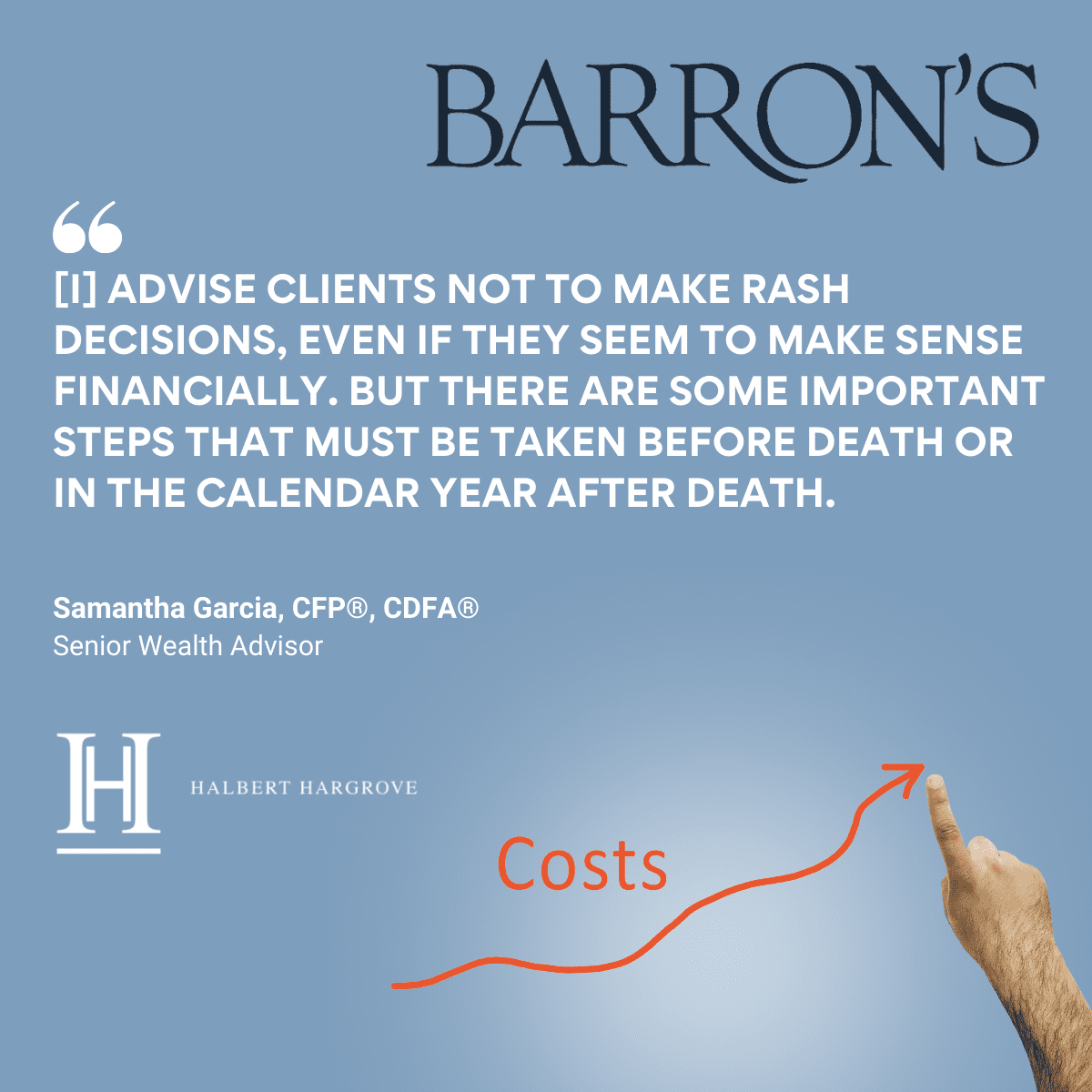By Debbie Carlson, in Barron’s, featuring Samantha Garcia, CFP®, AIF®, CDFA®, Senior Wealth Advisor at Halbert Hargrove
Nancy Tengler always handled her family’s finances, a natural extension of her job as CEO of Laffer Tengler Investments, but she wasn’t prepared for the financial upheaval caused by the death of her husband seven years ago.
Tengler’s husband had been fighting to recover from an extended illness, so they hadn’t taken steps to organize their assets for tax efficiency if he died.
“It never occurred to me that I would go up in a higher income tax bracket” as a single filer, says Tengler, 66.
When a spouse dies, money is often the furthest from a surviving spouse’s mind. But their financial picture may dim as one Social Security payment ceases and they are pushed into a higher tax bracket as a single filer.
There are financial moves widows and widowers can take within a year after their spouse dies to protect their future financial position.
A World Turned Upside Down
Couples receiving Social Security income will see it reduced when a spouse dies, and the survivor receives only the higher of the two benefits. Samantha Garcia, senior wealth advisor at Halbert Hargrove, says there is a one-time death payment for a spouse of $255, but the agency may also claw back the last month of benefits, often offsetting the additional payment.
The surviving spouse generally can still use the higher married-couple-filing-jointly tax bracket for the next tax year. Unless the surviving spouse meets qualifications for widow or widower status, he or she will file a single tax return the following year, with its much lower standard deductions and reduced threshold for tax brackets. For example, a single person using the $14,600 standard deduction will hit the 22% bracket if his or her taxable income reaches $61,751, while a married couple using the $29,200 standard deduction can make up to $123,499 before hitting the 22% bracket.
Healthcare costs may rise, as Medicare premiums are tied to income. Couples pay the standard premium of $174.70 up to income of $206,000; but single people pay it only to $103,000. Incomes above those levels are subject to steep premium bumps. For working-age couples, death may mean loss of access to an employer-provided health plan, and the surviving spouse may need to access Cobra or buy insurance on the open market, says Hollis Hardiman, certified divorce financial analyst and partner at Merit Financial Advisors. Tengler lost her husband when she was about 59, which is the average age of widowhood for women, according to the U.S. Census Bureau.
The smaller costs and loss of discounts can add up as well. Hardiman says veterans benefits such as reduced license-plate fees, property-tax reductions, or healthcare benefits will end if the deceased spouse was a veteran. Home maintenance costs may rise, especially if the surviving spouse now needs to pay for services such as lawncare or snow removal.
Couples’ discounts for insurance premiums and loyalty programs cease as well. Garcia says while some costs may drop, they may not be cut in half. For example, cellphone plans may be cheaper with one less line, but the bill could still be two-thirds of what it was.
Prepare for the Worst
Not all deaths are foreseeable, so it’s worth it for couples to set aside time every three to five years to review beneficiaries, trusts, and making assets are properly titled. These are all actions that Tengler had to take following her husband’s death—tasks that took longer to accomplish on her own.
In the fog of grief that first year, she says she failed to make key financial moves. She missed out on completing Roth conversions of individual retirement accounts. Owners of pretax accounts can move their assets to an after-tax Roth account, and the amount converted is taxed as ordinary income. It makes sense to complete a Roth conversion while the surviving spouse can take advantage of the higher standard deduction and more generous tax brackets when filing as a married couple.
And she didn’t sell their primary home to take advantage of their joint $500,000 capital-gains exemption as a couple. When she did sell it four years later, she got only half as much of the profits protected from capital-gains taxes. Losing his $250,000 exemption “was a real gut punch,” she says.
Garcia says she advises clients not to make rash decisions, even if they seem to make sense financially. But there are some important steps that must be taken before death or in the calendar year after death.
Hardiman worked with a couple where the wife got pancreatic cancer. Before she died, Hardiman moved stocks with large capital gains out of a joint account into one solely in the wife’s name. When the husband inherited the stocks after her death, he received the equities at their current value and will pay no taxes on the gains.
Garcia used accumulated capital losses for a couple to offset gains in a trust brokerage account after the husband died earlier this year. Normally capital losses expire when the investor dies, but spouses have the right to use those losses the same calendar year. As Garcia redid the revocable trust, she was able to sell highly appreciated assets and take advantage of the losses.
Garcia suggests high-net-worth surviving spouses file a 706 estate tax return, even if they don’t owe estate taxes. The estate can elect to transfer to the widow or widower any deceased spousal unused exclusions, preserving the spouse’s exemption for themselves.
Doing so “could eliminate estate taxes for your kids when they inherit all of it,” she says.


